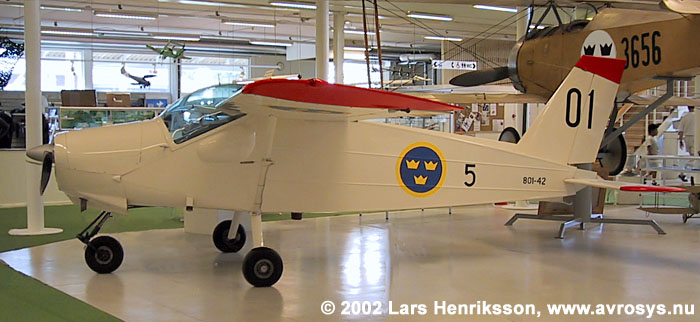|
|
||
| FPL 801 - Malmö Flygindustri MFI-9B Militrainer (1966-1968) | ||
| Page 1 (1) | ||
|
|
||
 |
||
|
The
AB Malmö Flygindustri (MFI) first commercial success - the MFI-9 - was
based on Björn Andreasson’s BA-7, a two-seat aircraft he designed and
built as a prototype in his garage when he was employed at Convair in
the USA in the 1950s. Björn Andreasson has played an important role in
the development of light aircraft in Sweden. Andreasson,
had worked at MFI’s forerunner AB Flygindustri (AFI) 1942-1945. In
1960 he returned to MFI and the company decided to further develop his
BA-7. The main modifications were a more powerful engine and a larger
cockpit. The first trial flights of the modified design, now called
MFI-9, began in May 1961. The German aircraft manufacturer Bölkow
discovered the small but capable MFI-9 and signed an agreement for
license production in July the same year. Next year, the MFI-9 was
displayed at the large aviation exhibition in Hannover. The
MFI-9 was further developed for military use under the name MFI-9B
Militrainer. ASW, light attack and training were some of the duties the
aircraft could perform. The armament would be fitted in pods under the
wings and consist of machine guns or rockets. For this reason, the wings
were reinforced. The aircraft was designed to fulfil the demands for a
new basic trainer, but was also contemplated as a successor to the FPL
51 Piper Super Cub. The
idea behind the Militrainer as a combat aircraft compared with more
expensive aircraft was primary that a large number of small and cheap
aircraft could be bought instead of a few advanced, but expensive and
vulnerable ones. The Militrainer could do most of the jobs- a treetop
level and based at primitive airstrips. Take off and landing could be
done at only 150 meters. The
Air Force showed a certain interest of the concept. Trials proved that
the aircraft was easy to maintain under active-service field conditions
and tests with the wire-controlled missile Bantam were successful. Also
test with two pods with a 7,62 mm machine-gun or an armament of six 7,5
cm rockets were executed. But the Air Force saw no demand of an
ultra-light attack aircraft. Instead, ten MFI-9B were leased from MFI to
be evaluated as basic trainers. All ten were delivered in 1966 and were
tested at the War Flying School (F 5) at Ljungbyhed. They got the Air
Force designation FPL 801. But the aircraft was regarded as too small,
in particulary the narrow cockpit. The ten MFI-9B were returned to MFI
after a year and sold to other customers. Instead, the Air Force chose
the Scottish Aviation Bulldog (SK 61) as basic trainer. In
1969, the MFI-9B really saw active military service. The Nigerian
province Biafra had declared itself independent and a civil war had
broken out. The population of Biafra suffered from starvation and
airborne relief consignments had begun to be arranged. The Nigerian Air
Force made its best to disturb these relief flights. One of the
organizers of the flights, Carl Gustaf von Rosen of Transair,
reorganized the Biafran Air Force with nine MFI-9B which each were
fitted with twelve French MATRA anti-tank rockets. Their daring
activities were successful, but Biafra lost the war and had to give up
independence. In
1968, SAAB bought MFI. The MFI-9 was further developed and the SAAB
MFI-15 Safari and MFI-17 Supporter served in a number of countries.
The
FPL 801 was powered by a RR Continental 0-200-A engine of 100 hp. Photo:
FPL 801, Sw AF/n 801-42, at Flygvapenmuseum. After its time as Air Force
evaluation aircraft, it carried the civil registration SE-EUK. Span 7,40 m. Length 5,90 m. MTOW 600 kg. Maximum speed 240 km/h.
|
||
|
|
||
|
|
||
|
|
||
|
|
||
|
© Lars Henriksson |
|
Updated 2010-07-14 |
|
|
||